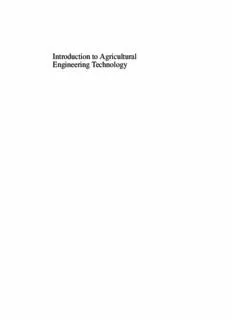Table Of ContentP1:OTE/SPH P2:OTE
SVNY306-Field&Solie April15,2007 8:40
Introduction to Agricultural
Engineering Technology
i
P1:OTE/SPH P2:OTE
SVNY306-Field&Solie April15,2007 8:40
Introduction to Agricultural
Engineering Technology
A Problem Solving Approach
Third Edition
Harry L. Field and John B. Solie
OklahomaStateUniversity
Stillwater,OK,USA
iii
P1:OTE/SPH P2:OTE
SVNY306-Field&Solie April15,2007 8:40
HarryL.Field JohnB.Solie
OklahomaStateUniversity,Stillwater,OK, OklahomaStateUniversity,Stillwater,OK,
USA USA
111AgriculturalHall 111AgriculturalHall
Stillwater74078 Stillwater74078
[email protected] [email protected]
LibraryofCongressControlNumber:2006930107
ISBN-10:0-387-36913-9 e-ISBN-10:0-387-36915-5
ISBN-13:978-0-387-36913-6 e-ISBN-13:978-0-387-36915-0
Printedonacid-freepaper.
(cid:2)C 2007SpringerScience+BusinessMedia,LLC
Allrightsreserved.Thisworkmaynotbetranslatedorcopiedinwholeorinpartwithoutthewritten
permissionofthepublisher(SpringerScience+BusinessMedia,LLC233SpringStreet,NewYork,
NY10013,USA),exceptforbriefexcerptsinconnectionwithreviewsorscholarlyanalysis.Use
in connection with any form of information storage and retrieval, electronic adaptation, computer
software,orbysimilarordissimilarmethodologynowknownorhereafterdevelopedisforbidden.
Theuseinthispublicationoftradenames,trademarks,servicemarks,andsimilarterms,evenifthey
arenotidentifiedassuch,isnottobetakenasanexpressionofopinionastowhetherornottheyare
subjecttoproprietaryrights.
9 8 7 6 5 4 3 2 1
springer.com
iv
P1:OTE/SPH P2:OTE
SVNY306-Field&Solie April15,2007 8:40
Contents
1. ProblemSolving................................................................ 1
2. SignificantFiguresandStandardForm.................................. 17
3. CommonUnitsofMeasure.................................................. 23
4. SimpleMachines............................................................... 36
5. InternalCombustionEngines............................................... 49
6. PowerTrains.................................................................... 61
7. TractorsandPowerUnits.................................................... 80
8. MachineryCalibration....................................................... 93
9. EquipmentEfficiencyandCapacity....................................... 118
10. EconomicsofAgriculturalMachinery.................................... 129
11. SoundandNoise................................................................ 152
12. MeasuringDistance............................................................ 159
13. AnglesandAreas............................................................... 175
14. LandDescription............................................................... 196
15. DifferentialandProfileLeveling........................................... 204
16. Weather........................................................................... 221
v
P1:OTE/SPH P2:OTE
SVNY306-Field&Solie April15,2007 8:40
vi Contents
17. WaterRunoff.................................................................... 234
18. ErosionandErosionControl................................................ 244
19. Irrigation......................................................................... 253
20. Handling,MoistureManagement,andStorageof
BiologicalProducts............................................................ 266
21. AnimalWasteManagement................................................. 279
22. InsulationandHeatFlow.................................................... 286
23. Heating,Ventilation,andAir-Conditioning............................. 293
24. SelectionofStructuralMembers........................................... 319
25. PrinciplesofElectricity....................................................... 326
26. SeriesandParallelCircuits.................................................. 331
27. SizingConductors.............................................................. 340
28. ElectricMotors................................................................. 347
Appendices 356
Index 371
P1:GFZ
SVNY306-Field&Solie March28,2007 8:35
1
Problem Solving
1.1. Objectives
1. Beabletodefineproblemsolving.
2. Beabletodescribethecommonproblem-solvingmethods.
3. Beabletoselecttheappropriatemethodforsolvingaproblem.
4. Understandthefunctionanduseofspreadsheets.
5. Understandtheuseofandcommonsymbolsforflowcharts.
1.2. Introduction
Problem solving is a part of living. We are faced with a host of problems on a
dailybasis.Someoftheseproblemsinvolvepeopleandhumanrelations,whereas
othersrequireamathematicalsolution.Inthischapterwewilldealwithproblems
involvingmathematicalsolutions,andseveralwaysinwhichtheseproblemscan
beapproached.
1.3. Mathematical Problem Solving
Mathematicalproblemsolvingistheprocessbywhichanindividualusesprevi-
ouslyacquiredknowledge,skills,andunderstandingtosatisfythedemandsofan
unfamiliarsituation.Theessenceoftheprocessistheabilitytouseinformation
andfactstoarriveatasolution.Therearetwocharacteristicsofproblemsolving
thatmustberememberedwhensolvingproblemsusingmathematicalprocesses.
1. The mathematical process does not always give you the answer—just more
informationsothatyoucanmakeamoreinformeddecision.Gooddecision-making
requiresgoodinformation.
2. Wheneverperfectionisnotpossibleorexpected,levelsorintervalsofaccept-
abilitymustbeestablished.Whenperfectionisnotpossiblesomeonemustdeter-
minetheamountoferrorthatisacceptable.Theacceptableleveloferrormaybe
1
P1:GFZ
SVNY306-Field&Solie March28,2007 8:35
2 1. ProblemSolving
determinedbystandards,manufacturers’recommendations,comparisontoanother
situationsormachinesorpersonalexperience.
Bothofthesecharacteristicswillbeutilizedandexplainedinmoredetailinlater
chaptersbyusingexamples.
Problemscanbesolvedindifferentways.Oneoftheobjectivesofthischapter
istoincreasethereader’sknowledgeofproblem-solvingmethods.Sevendifferent
approaches to solving mathematical problems will be discussed: diagrams and
sketches,patterns,equationsandformulas,unitscancellation,intuitivereasoning,
spreadsheets,andflowcharts.
1.3.1. Diagrams and Sketches
Someproblemsinvolvethedeterminationofaquantityofitems,suchasthenumber
of nails per sheet of plywood or the number of studs in a wall. In solving these
typesofproblemsitusuallyishelpfultodrawasketchoradiagram.
Problem: Howmanypostsareneededtobuildafence100ftlongwithposts10ft
apart?
Solution: Formanypeoplethefirstresponsewouldbe10:
100ft
Posts= =10posts
10.0ft/post
butadiagram,Figure1.1showsthatthecorrectnumberofpostsis11.
This is an example of a situation where a wrong answer is possible if you do
notinterprettheproblemcorrectly.Inthisexample,10isthenumberofspaces,
notthenumberofposts.
FIGURE1.1. Numberofposts.
1.3.2. Patterns
Thesolutiontosomeproblemsmaydependuponone’sbeingabletodiscovera
patterninanarrayofnumbersorvalues.Frequently,itisconvenienttoexaminethe
patternsinasampleratherthantheentirepopulation.Onceapatternisdiscovered
andshowntobeconsistentforthesample,itcanbeusedtopredictthesolution
fortheentirepopulation.
P1:GFZ
SVNY306-Field&Solie March28,2007 8:35
MathematicalProblemSolving 3
TABLE1.1. Patternsinnumbers,firstsample.
Cownumber
Ration Child 1 2 3 4 5 6 7 8 9 10
Grain 1 N N N N N N N N N N
Mineral 2 Y Y Y Y Y
Hay 3 Y Y Y
Silage 4 Y Y
Water 5 Y Y
Problem: Adairyfarmerhasfivechildren.Eachchildisresponsibleforonepart
ofthedailyfeedrationforthefamily’s100dairycows.Theoldestisresponsible
forthegrain,thesecondfortheminerals,thethirdforthehay,thefourthforthe
silage,andthefifthforwater.Insteadoffeedingeachcow,thefirstchilddecides
shewillnotfeedthecowsatallthatday.Thesecondchilddecidesjusttofeedevery
other cow, the third child feeds every third cow, and so on. Dad soon discovers
howthecowswerefed,andneedstoknowwhichcowsdidnotreceiveanyfeed
orwater.
Solution: Whenoneisfacedwiththistypeofproblem,itisusuallyhelpfultoset
upatable.Inthiscase,itwouldbeverytime-consumingtosetupatableforall100
cows.Instead,selectasampleofthecows.Ifapatternistrueforthesample,there
is a high probability that the pattern will be true for a large group. Determining
thesizeofasampleisnotalwayseasy.Pickone,andifaclearpatterndoesnot
appear, increase the size until a pattern develops. We will start with the first 10
cows,Table1.1.
Inthissample,cows#1and#7didnotreceiveanygrain,mineral,hay,silage,
orwater.Isthisenoughinformationtoestablishapattern?Wewillpredictthatthe
nextcowthatdidnotreceiveanyfeedorwateris#11.Why?Totestthisprediction,
thesamplesizemustbeextendedtoincludealargernumberofcows.
Table 1.2 shows that the prediction was right; cow #11, along with #13, #17,
and#19,didnotreceiveanygrain,minerals,hay,silage,orwater.Itisnowsafeto
considerthatthepredictioncouldbeusedtoidentifyalloftheanimalswithinthe
herdthatdidnotreceiveanygrain,minerals,hay,silage,orwater(thoseanimals
representedbyprimenumbers,thatis,anumberdivisibleonlybyitselfandone).
TABLE1.2. Patternsinnumbers,secondsample.
Cownumber
Ration Child 11 12 13 14 15 16 17 18 19 20
Grain 1 N N N N N N N N N N
Mineral 2 Y Y Y Y Y
Hay 3 Y Y Y
Silage 4 Y Y Y
Water 5 Y Y
P1:GFZ
SVNY306-Field&Solie March28,2007 8:35
4 1. ProblemSolving
1.3.3. Equations and Formulas
Equationsandformulasareverysimilarproblem-solvingtools.Sometextsstudy
themseparately,butinthissectiontheywillbecombined.Equationsareawayof
showingtherelationshipbetweendifferentvariablesinaproblemandareusually
derivedasneededforeachproblem.Formulasareequationsthatareusedfrequently
enoughoraresomehowuniqueenoughthattheyarerememberedandusedwithout
aderivation.
1.3.3.1. Equations
Thesolutiontosomeproblemsrequiresthederivationofamathematicalequation
based on a pattern or another type of relationship between the numbers. These
equationswillbeuniqueforeachproblem.
Problem: Howmuchwireisneededtobuildasinglewirefencearoundarectan-
gularfieldmeasuring450ftlongand350ftwide?
Solution: Inthisexampletherearethreequantities:length,width,andperimeter.
It should be obvious that the perimeter is a function of the other two. Begin by
assigning the variables L to represent the length, W to represent the width, and
Prtorepresenttheperimeter.Then,becausearectanglehastwolengthsandtwo
widths,theperimetercanbefoundasfollows:
Pr=(L+L)+(W +W)
Pr=(450ft+450ft)+(350ft+350ft)
=900ft+700ft
=1,600ft
1.3.3.2. Formulas
Forsomeproblemstherelationshipsofthevariablesarefixedandconstant,sothe
equationforthatproblemisrememberedandused.Theseequationsaresometimes
calledformulas.Anothercharacteristicofformulasisthattheyusuallycontaina
constant.Oneexampleistheareaofacircle:A=πr2.Thevariableπisaconstant.
Thereareatleasttwoimportantconsiderationsinusingformulas.
1. Youmustenterthenumberswiththecorrectunitsofmeasure.Allformulasare
designedwithspecificunitsforthenumbers,especiallyiftheyhaveaconstant.If
the units are incorrect, the answer will be incorrect. An example is the equation
usedtodeterminetheapplicationrateofaboomtypesprayer:
gal 5,940×Flowrate(gal/min)
Applicationrate =
ac Speed(mi/hr)×nozzlespacing(in)
It should be obvious that the units in the equation do not work (the units when
combineddonotresultintheunitsforapplicationrate,gal/min).Thisequationis
anexampleofasituationinwhichunitsconversionvalues,thatarealwaysused
P1:GFZ
SVNY306-Field&Solie March28,2007 8:35
MathematicalProblemSolving 5
eachtimetheproblemisworked,arecombinedintoaunitsconversionconstant
(5,940). If any one of the values is entered in different units, the answer will be
incorrect. When we solve for the application rate using units cancellation and
conversionvalues,thesourceoftheconstantbecomesapparent.
gal gal 60min 1hr 1mi
= × × ×
ac min 1hr 1mi 5,280ft
43,560ft2 12in 1
× × ×
1ac 1ft 1in
31,363,200
=
5,280
gal
=5,940
min
2. You must be able to rearrange the formula to solve for the unknown value.
Forexample,theapplicationrateequationcouldberearrangedtosolvefornozzle
spacingininches(nsi):
5,940×Flowrate(gal/min)
Nozzlespacing(nsi)=
Speed(mi/hr)×Applicationrate(gal/ac)
For the remainder of this text the terms equation and formula will be used as
synonyms.
1.3.4. Units Cancellation
Someproblemsaremorecomplexthantheexampleswehaveused,andmanydonot
havepatternsorpreviouslydevelopedequations.Equationscanbedevelopedfor
someoftheseproblems,butanalternativeapproachisunitscancellation.Problems
ofthistypewillusuallyinvolveseveralquantities.Allofthesequantities,except
π, will have a unit such as feet, pounds, gallons, and so on. Units cancellation
followstwomathematicalprinciples:(1)theunitsofmeasureassociatedwiththe
numbers (feet, gallons, minutes, etc.) follow the same mathematical rules as the
numbers;(2)theunitsofthenumbersbehaveaccordingtotherulesoffractions.
Forexample:
2×2=4or22
Withunitsoffeetthesameequationis:
2ft ×2ft=2×2andft×ftor4ft2
Toreviewtherulesoffractionsstudythefollowingexample:
3 4 3×4 3
× = =
4 5 4×5 5
Inthisexample,the4’sinthenumeratoranddenominatorcancelout(4/4=1).
Description:Introduction to Agricultural Engineering Technology: A problem Solving Approach is an invaluable text for agriculture students at the introductory level. The third edition has been thoroughly updated and reorganized to meet the current units and standards of the American Society of Agricultural and

